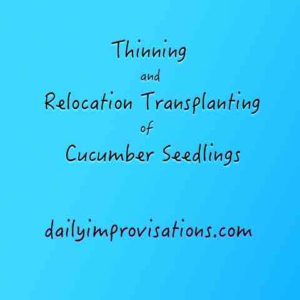
Dealing with uneven sprouting or changes in location preferences may be easier to do than you think. As I show in this video about moving cucumber seedlings, it can be done quickly and with minimal impact on the seedling.
I have even moved seedlings that are notoriously picky about root disturbance this way, such as Shirley poppies. I have done it with more seedlings than I can remember, but I have specifically written about doing it with leeks. It is usually worth experimenting with, because in many cases, the seedlings that get moved would just have to be thrown away. I mention such transplanting in point 7 of this blog about 10 top things to do in June, much of which I think could still be applied to July. It just depends on the weather and your succession planting strategy.
In case you want a written reference of key points on the process of transplanting out of the garden to a new place in the garden:
- Do your transplanting on a mild weather day or in the evening.
- Dig holes first in the intended new location. How important this is will depend on the weather. The point is that less time for the plant in transit, the better.
- Choose seedlings that relatively small, but look strong. I usually find that those with their first set of true leaves are very good candidates for this type of transplanting.
- Make sure the soil is moderately damp, so that not only is the seedling sufficiently watered and not under stress from drought, but the soil will be easier to dig into and will hold together around the root mass.
- Estimate that the roots you want to contain are about the size of the foliage above ground.
- Take the root mass in one shovel full. If you cut a few, that will probably be okay, but the goal is to disturb the whole mass as little as possible. Avoid extra motion and digging. Just get it in one scoop.
- Support the plant in transit by holding the root-dirt mass, either with the shovel, your hands, or a bucket. You want to keep as much dirt on it as you can. If you are holding it in the shovel, it may be helpful to support the top of the plant by gently holding a leaf, but avoid holding the stem. Any damage to the stem is the most life-threatening.
- Plant the seedling at the same level in the dirt as it was in its original location.
- Gently press, or tamp down, the soil around the seedling in its new location.
- Water the seedling in. Do this even if the soil is damp around it. The watering will help the soil settle in around the roots in a way that allow them to get to work. It will also give the seedlings some water to help them through the adjustment period.
- Keep an eye on your seedlings for the next few days to evaluate if they need a little extra attention, but don’t assume that a wilting plant needs more water. It might just be trying hard. More water might drown it. There might be different insect issues in the new location.
Hopefully this method of transplanting will open up new possibilities for you in making the most of your seedlings and having an abundant garden!

Leave a Reply